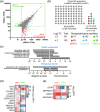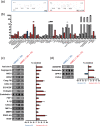Reproducing diabetic retinopathy features using newly developed human induced-pluripotent stem cell-derived retinal Müller glial cells
- PMID: 33683746
- PMCID: PMC8252429
- DOI: 10.1002/glia.23983
Reproducing diabetic retinopathy features using newly developed human induced-pluripotent stem cell-derived retinal Müller glial cells
Abstract
Muller glial cells (MGCs) are responsible for the homeostatic and metabolic support of the retina. Despite the importance of MGCs in retinal disorders, reliable and accessible human cell sources to be used to model MGC-associated diseases are lacking. Although primary human MGCs (pMGCs) can be purified from post-mortem retinal tissues, the donor scarcity limits their use. To overcome this problem, we developed a protocol to generate and bank human induced pluripotent stem cell-derived MGCs (hiMGCs). Using a transcriptome analysis, we showed that the three genetically independent hiMGCs generated were homogeneous and showed phenotypic characteristics and transcriptomic profile of pMGCs. These cells expressed key MGC markers, including Vimentin, CLU, DKK3, SOX9, SOX2, S100A16, ITGB1, and CD44 and could be cultured up to passage 8. Under our culture conditions, hiMGCs and pMGCs expressed low transcript levels of RLPB1, AQP4, KCNJ1, KCJN10, and SLC1A3. Using a disease modeling approach, we showed that hiMGCs could be used to model the features of diabetic retinopathy (DR)-associated dyslipidemia. Indeed, palmitate, a major free fatty acid with elevated plasma levels in diabetic patients, induced the expression of inflammatory cytokines found in the ocular fluid of DR patients such as CXCL8 (IL-8) and ANGPTL4. Moreover, the analysis of palmitate-treated hiMGC secretome showed an upregulation of proangiogenic factors strongly related to DR, including ANG2, Endoglin, IL-1β, CXCL8, MMP-9, PDGF-AA, and VEGF. Thus, hiMGCs could be an alternative to pMGCs and an extremely valuable tool to help to understand and model glial cell involvement in retinal disorders, including DR.
Keywords: Muller glial cells; diabetes; disease modeling; dyslipidemia; iPSC; retinopathy; stem cells.
© 2021 The Authors. GLIA published by Wiley Periodicals LLC.
Conflict of interest statement
OG, J‐AS, and SR are inventors on pending patents related to generation of retinal cells from human pluripotent stem cells.
Figures





Similar articles
-
MEK/ERK/RUNX2 Pathway-Mediated IL-11 Autocrine Promotes the Activation of Müller Glial Cells during Diabetic Retinopathy.Curr Eye Res. 2022 Dec;47(12):1622-1630. doi: 10.1080/02713683.2022.2129070. Epub 2022 Oct 10. Curr Eye Res. 2022. PMID: 36154781
-
Diabetic Müller-Glial-Cell-Specific Il6ra Knockout Mice Exhibit Accelerated Retinal Functional Decline and Thinning of the Inner Nuclear Layer.Invest Ophthalmol Vis Sci. 2023 Dec 1;64(15):1. doi: 10.1167/iovs.64.15.1. Invest Ophthalmol Vis Sci. 2023. PMID: 38038619 Free PMC article.
-
The glucocorticoid receptor as a master regulator of the Müller cell response to diabetic conditions in mice.J Neuroinflammation. 2024 Jan 25;21(1):33. doi: 10.1186/s12974-024-03021-x. J Neuroinflammation. 2024. PMID: 38273366 Free PMC article.
-
Multitarget Activities of Müller Glial Cells and Low-Density Lipoprotein Receptor-Related Protein 1 in Proliferative Retinopathies.ASN Neuro. 2022 Jan-Dec;14:17590914221136365. doi: 10.1177/17590914221136365. ASN Neuro. 2022. PMID: 36317314 Free PMC article. Review.
-
Müller cells and diabetic retinopathy.Vision Res. 2017 Oct;139:93-100. doi: 10.1016/j.visres.2017.03.013. Epub 2017 Sep 5. Vision Res. 2017. PMID: 28866025 Free PMC article. Review.
Cited by
-
Proteomic profiling and correlations with clinical features reveal biomarkers indicative of diabetic retinopathy with diabetic kidney disease.Front Endocrinol (Lausanne). 2022 Oct 5;13:1001391. doi: 10.3389/fendo.2022.1001391. eCollection 2022. Front Endocrinol (Lausanne). 2022. PMID: 36277688 Free PMC article.
-
Direct delivery of Cas9 or base editor protein and guide RNA complex enables genome editing in the retina.Mol Ther Nucleic Acids. 2024 Sep 30;35(4):102349. doi: 10.1016/j.omtn.2024.102349. eCollection 2024 Dec 10. Mol Ther Nucleic Acids. 2024. PMID: 39494148 Free PMC article.
-
Perilipin 2-positive mononuclear phagocytes accumulate in the diabetic retina and promote PPARγ-dependent vasodegeneration.J Clin Invest. 2023 Oct 2;133(19):e161348. doi: 10.1172/JCI161348. J Clin Invest. 2023. PMID: 37781924 Free PMC article.
-
Single-cell RNA sequencing highlights a significant retinal Müller glial population in dry age-related macular degeneration.iScience. 2025 Apr 17;28(5):112464. doi: 10.1016/j.isci.2025.112464. eCollection 2025 May 16. iScience. 2025. PMID: 40343286 Free PMC article.
-
Spatial and Temporal Development of Müller Glial Cells in hiPSC-Derived Retinal Organoids Facilitates the Cell Enrichment and Transcriptome Analysis.Front Cell Neurosci. 2022 May 19;16:820396. doi: 10.3389/fncel.2022.820396. eCollection 2022. Front Cell Neurosci. 2022. PMID: 35663427 Free PMC article.
References
-
- ACCORD Study group , ACCORD Eye Study Group , Chew, E. Y. , Ambrosius, W. T. , Davis, M. D. , Danis, R. P. , … Fine, L. J. (2010). Effects of medical therapies on retinopathy progression in type 2 diabetes. The New England Journal of Medicine, 363(3), 233–244. 10.1056/NEJMoa1001288 - DOI - PMC - PubMed
-
- Babapoor‐Farrokhran, S. , Jee, K. , Puchner, B. , Hassan, S. J. , Xin, X. , Rodrigues, M. , … Sodhi, A. (2015). Angiopoietin‐like 4 is a potent angiogenic factor and a novel therapeutic target for patients with proliferative diabetic retinopathy. Proceedings of the National Academy of Sciences of the United States of America, 112(23), E3030–E3039. 10.1073/pnas.1423765112 - DOI - PMC - PubMed
-
- Bromberg‐White, J. L. , Glazer, L. , Downer, R. , Furge, K. , Boguslawski, E. , & Duesbery, N. S. (2013). Identification of VEGF‐independent cytokines in proliferative diabetic retinopathy vitreous. Investigative Ophthalmology & Visual Science, 54(10), 6472–6480. 10.1167/iovs.13-12518 - DOI - PubMed
Publication types
MeSH terms
LinkOut - more resources
Full Text Sources
Other Literature Sources
Medical
Molecular Biology Databases
Research Materials
Miscellaneous

